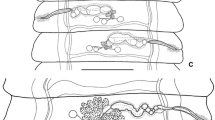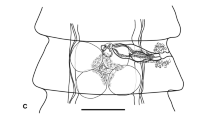Abstract
Armadolepis (Armadolepis) spasskyi Tenora & Baruš, 1958 is redescribed on the basis of the type-series consisting of the holotype from the garden dormouse Eliomys quercinus (Linnaeus) (type-host) and a paratype from the forest dormouse Dryomys nitedula (Pallas); the occurrence of this species in the fat dormouse Glis glis (Linnaeus) cannot be confirmed due to the lack of specimens from this host species both in the type-series and other studied samples. The main corrections in the diagnostic characters of A. spasskyi are related to the number and length of the rostellar hooks (12 hooks, 12–14 µm long versus 16–19 hooks, 15.3–17.1 µm long in the original description) and the position of the testes in triangle (versus in line as originally described). Specimens originally identified as Hymenolepis myoxi (Rudolphi, 1819) by Genov (1984) from the fat dormouse G. glis from Bulgaria are described as Armadolepis (Bremserilepis) genovi n. sp. The new species differs from the congeners by the presence of a rudimentary rostellum and rudimentary rostellar hooks; the new species differs from the other two species of the subgenus, A. (B.) myoxi and A. (B.) longisoma, by its longer cirrus-sac (196–240 µm), scolex diameter of 180–300 µm (wider than that of A. myoxi and narrower than that of A. longisoma) and wider ovary (220–310 µm). Cestodes previously reported as Hymenolepis myoxi from E. quercinus from Switzerland and France (western and north-western Alps) are now identified as Armadolepis (A.) jeanbaeri Makarikov, 2017. Cestodes from G. glis from Switzerland and Slovakia, previously identified as Hymenolepis sulcata (von Linstow, 1879), are now identified as Armadolepis (B.) myoxi (sensu stricto). The position of Hymenolepis (s.l.) sciurina Cholodkovsky, 1913 as a subspecies of A. myoxi is rejected and it is considered a species inquirenda.





Similar content being viewed by others
References
Baer, J.-G. (1932). Contribution à la faune helminthologique de Suisse (Deuxième partie). Revue Suisse de Zoologie,39, 1–57.
Dudiňák, V., & Špakulová, M. (2005). A survey of helminth species originally described from Slovakia supplemented by a list of the type material deposited in the East-Slovakian Museum (Výhodoslovenské muzeum) in Košice. Helminthologia,42, 233–245.
Erhardová, B. (1958). Parasiticti cervi hlodavcu Československa. Československá Parasitologie,5, 27–103.
Faivre, J. P., & Vaucher, C. (1978). Redescription de Hymenolepis sulcata (von Linstow, 1879), parasite du loir Glis glis (L.). Bulletin de la Société Neuchâteloise des Sciences Naturelles,101, 53–58.
Genov, T. (1984). [Helminths of insectivores and rodents in Bulgaria.] Sofia: Izdatelstvo na Bulgarskata Akademiya na Naukite, 348 pp (In Bulgarian).
Haukisalmi, V., Hardman, L. M., Foronda, P., Feliu, C., Laakkonen, J., Niemimaa, J., et al. (2010). Systematic relationships of hymenolepidid cestodes of rodents and shrews inferred from sequences of 28S ribosomal RNA. Zoologica Scripta,39, 631–641.
Holden, M. E. (2005). Family Gliridae. In: D. E. Wilson & D. M. Reeder (Eds.) Mammal species of the world: A taxonomic and geographic reference (3rd ed.). Baltimore, Maryland: Johns Hopkins University Press, pp. 840–841.
ICZN (2012). International Commission on Zoological Nomenclature: Amendment of articles 8, 9, 10, 21 and 78 of the International Code of Zoological Nomenclature to expand and refine methods of publication. Bulletin of Zoological Nomenclature,69, 161–169.
Joyeux, C., & Baer, J.-G. (1936). Faune de France. 30. Cestodes. Paris: P. Lechevalier, 613 pp.
Makarikov, A. A. (2017). A taxonomic review of hymenolepidids (Eucestoda, Hymenolepididae) from dormice (Rodentia, Gliridae), with descriptions of two new species. Acta Parasitologica,62, 1–21.
Makarikov, A. A., Gulyaev, V. D., & Kontrimavichus, V. L. (2011). A redescription of Arostrilepis horrida (Linstow, 1901) and descriptions of two new species from Palaearctic microtine rodents, Arostrilepis macrocirrosa sp. n. and A. tenuicirrosa sp. n. (Cestoda: Hymenolepididae). Folia Parasitologica,58, 108–120.
Makarikov, A. A., Stakheev, V. V., & Tkach, V. V. (2018). Phylogenetic relationships of the genus Armadolepis Spassky, 1954 (Eucestoda, Hymenolepididae), with descriptions of two new species from Palaearctic dormice (Rodentia, Gliridae). Systematic Parasitology,95, 65–79.
Murai, E., & Tenora, F. (1977). Hymenolepis sulcata (von Linstow, 1879): Occurrence in Glis glis (Rodentia) in Hungary. Parasitologia Hungarica,10, 63–66.
Neov, B., Vasileva, G. P., Radoslavov, G., Hristov, P., Littlewood, D. T. J., & Georgiev, B. B. (2019). Phylogeny of hymenolepidid cestodes (Cestoda: Cyclophyllidea) from mammalian hosts based on partial 28S rDNA, with focus on parasites from shrews. Parasitology Research,118, 73–88.
Spassky, A. A. (1954). Classification of hymenolepidids of mammals. Trudy Gelʼmintologcheskoy Laboratorii Akademii Nauk SSSR, 7, 120–167. (In Russian).
Tenora, F. (1965). Supplementary notes on hymenolepidid tapeworms parasitizing glirid dormice in south Slovakian limestone area Czechoslovakia. Československá Parasitologie,12, 299–303.
Tenora, F. (1967). The helminthofauna of small rodents of the Roháčska dolina valley (Liptovské Hole Mts., Slovakia). Acta Scientiarum Naturalium Academiae Scientiarum Bohemicae, Brno,1, 29–68.
Tenora, F., & Baruš, V. (1958). Armadolepis spasskyi sp. n., eine neue Bandwurmart aus Nagern der Fam. Myoxidae. Folia Zoologica, 7, 339–342.
Tenora, F., Baruš, V., & Koubková, B. (1999). Remarks on tapeworms of the family Hymenolepididae (Cyclophyllidea) parasitizing dormice (Gliridae: Rodentia) in Europe. Acta Universitatis Agriculturae et Silviculturae Mendelianae Brunensis,47, 13–23.
Vaucher, C., & Quentin, J. C. (1975). Présence du cysticercoïde de Hymenolepis myoxi (Rud., 1819) chez la Puce du lérot et redescription du ver adulte. Bulletin de la Société Neuchâteloise des Sciences Naturelles,98, 27–34.
Žarnowski, E. (1955). Parasitic worms of forest micromammalians (Rodentia and Insectivora) of the environment of Pulawy (district Lublin). I. Cestoda. Acta Parasitologica Polonica, 3, 279–368. (In Polish).
Zhaltsanova, D.-S. D. (1992). [Helminths of mammals in the basin of Lake Baikal.] Moscow: Izdatel’stvo Nauka, 204 pp (In Russian).
Acknowledgements
We thank the curators of the helminthological collections Dr Jean Mariaux (Natural History Museum, Geneva, Switzerland) and Dr Tomas Scholz (Institute of Parasitology, Biology Centre, Czech Academy of Sciences, České Budějovice, Czech Republic) for enabling the access to cestode specimens used in the present study.
Funding
A substantial part of this work was funded by a research project included in the collaborative programme of the Russian Foundation for Basic Research (no. 19-54-18015) and the National Science Fund of Bulgaria (no. KP-06-Russia-06). Further support for AAM was provided by the Federal Fundamental Scientific Research Program for 2013–2020, Grant No. VI.51.1.5 (AAAA-A16-116121410121-7). The scientific visit of AAM to the Natural History Museum, Geneva, Switzerland, was funded by the MHNG.
Author information
Authors and Affiliations
Corresponding author
Ethics declarations
Conflict of interest
The authors declare that they have no conflict of interest.
Ethical approval
This article does not contain any studies with animals performed by any of the authors.
Additional information
Publisher's Note
Springer Nature remains neutral with regard to jurisdictional claims in published maps and institutional affiliations.
This article was registered in the Official Register of Zoological Nomenclature (ZooBank) as D81D1B2B-10FB-4372-90F8-BE7EA56248EC. This article was published as an Online First article on the online publication date shown on this page. The article should be cited by using the doi number. This is the Version of Record.
This article is part of the Topical Collection Cestoda.
Rights and permissions
About this article
Cite this article
Makarikov, A.A., Georgiev, B.B. Review of records of hymenolepidids (Eucestoda: Hymenolepididae) from dormice (Rodentia: Gliridae) in Europe, with a redescription of Armadolepis spasskyi Tenora & Baruš, 1958 and the description of A. genovi n. sp.. Syst Parasitol 97, 83–98 (2020). https://doi.org/10.1007/s11230-019-09891-7
Received:
Accepted:
Published:
Issue Date:
DOI: https://doi.org/10.1007/s11230-019-09891-7




